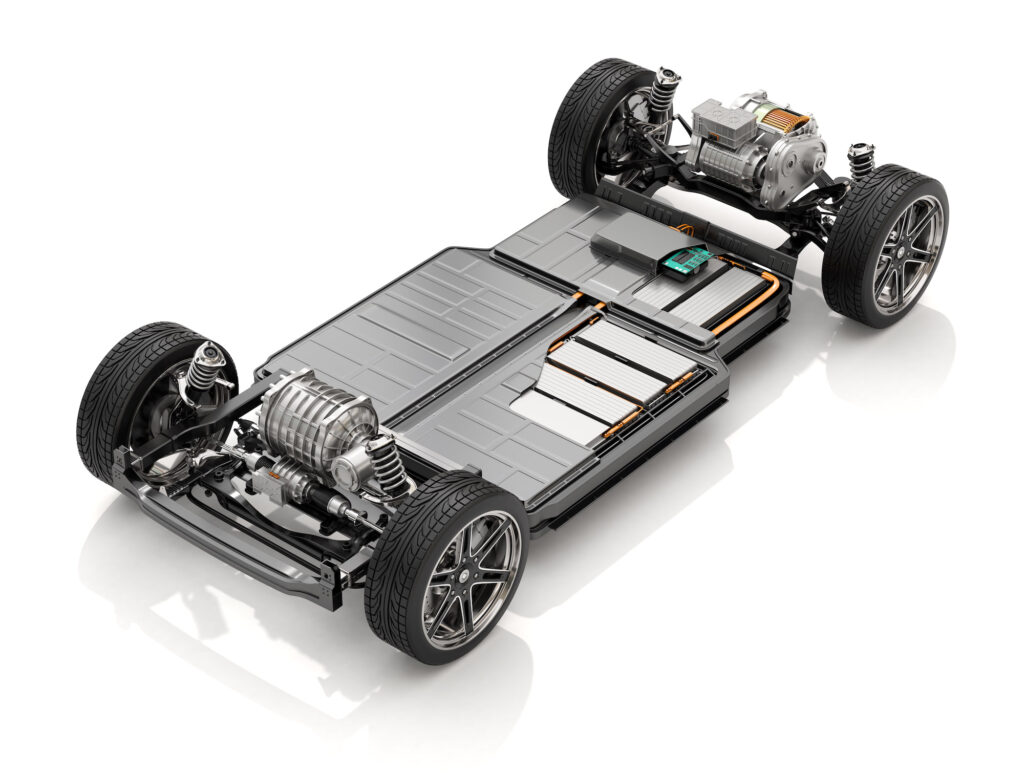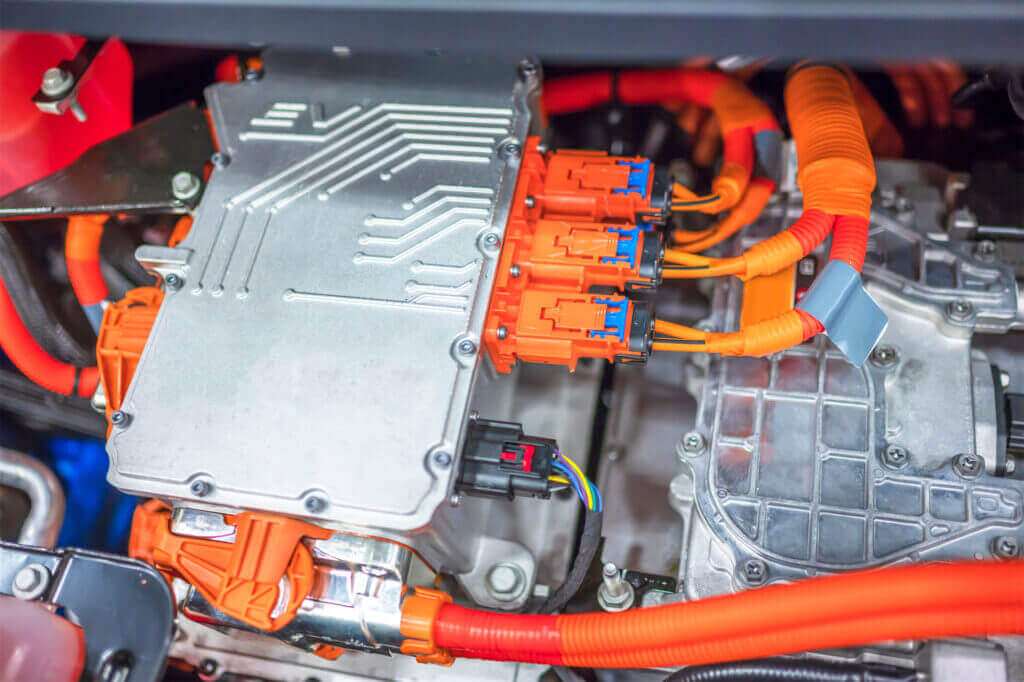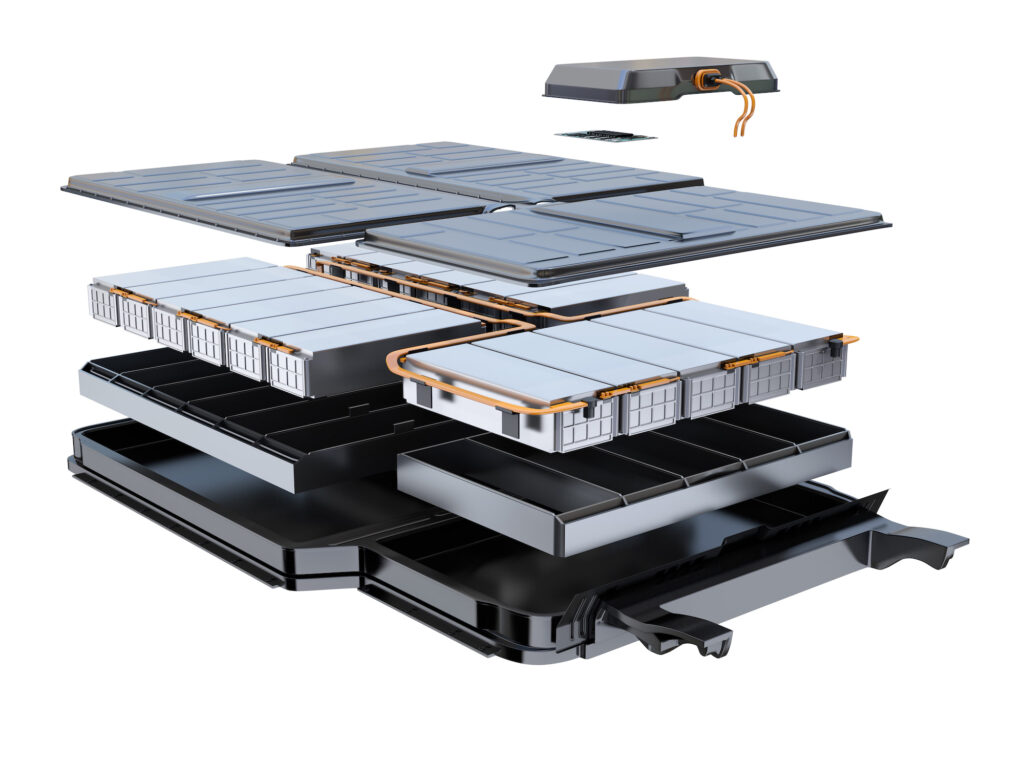BEV SOLUTIONS
- BEV Plating Solutions
The future of automotive is electric
As concerns over the climate crisis continue to grow, so does the demand for electric vehicles. Despite the obvious benefits of BEVs, the successful adoption of them requires new solutions in the automotive industry to address new end-user concerns like fire protection, corrosion and impact protection, temperature management and electrical shielding. Just as KC Jones has done for the last sixty-five years we are adapting to offer these unique finishing solutions to our customers.

Custom Coatings for Better Batteries
KC Jones’ unique line of functional coatings and plating solutions can play a key role in enhancing the performance and sustainability of Battery Electric Vehicles by:
- Protecting critical components from corrosion and external elements
- Increasing battery pack life
- Promoting increased adhesion for long-term durability
- Enabling lightweight materials throughout
- Protecting current collectors and increasing cell capacity in Lithium-ion batteries

Coating the Components
Our coating solutions can be applied in key drivetrain components throughout BEVs, including:
- Battery Cells
- Battery Cans
- Battery Packs
- Battery Trays
- Cooling Plates
- E-Motors
- Electrical Bus Bar
- Electrical Connectors and Terminals
- Heat Sinks
- Magnetic Generators and Motors
- Neodymium (NdFeB) Magnet Surface Treatment
- Power Conversion Inverters

BEV Plating Processes:
Several BEV applications, including electrical and battery bus bar and terminals, require a multi-layer plating system. These multi layers typically contain: copper, nickel, tin, or silver.
Common multi-layer systems for electrical bus bar and terminal applications include quality finishes in:
- Copper, Tin (Cu, Sn)
- Copper, Nickel (Cu/Ni)
- Copper, Nickel, Tin (Cu/Ni/Sn)
- Copper, Nickel, Tin, Silver (Cu/Ni/Sn/Ag)
KC Jones BEV Coating Solutions
Copper Plating
Copper is a ductile, soft metal, and it’s a superb conductor of electrical current. Copper coatings are generally used as intermediate layers within the electrical and automotive industries, on steels, and in electroplating before nickel or tin plating. When used as an intermediate coating in an exceedingly duplex coating like Cu/Ni/Sn or Cu/Sn layer system, for example, only layer thicknesses of 2-5µm are required, which function as diffusion barriers and enhance the adhesive strength of the layers or corrosion protection.
Electroless nickel plating is an autocatalytic nickel-phosphorus alloy deposition process. The phosphorus content can be selected between 2-4% (Low-Phos), 5-9% (Mid-Phos) or 10-12% (High-Phos). The deposited layer thicknesses are usually in the range of 0.5-30µm, are RoHS compliant, and conditionally ferromagnetic with hardnesses in the range between 500-580 HV 0.1. Electroless nickel layers with a phosphorus content <10% become more ferromagetic with a lower phosphorus content in the plating deposit. With a phosphorus content of greater than 10%, the coating becomes non-magnetic, ferromagnetic properties, and hardness of up to 980 HV can be achieved with a heat treatment after plating content >10% non-magnetic, ferromagnetic properties and harnesses up to 980 HV 0.1 can be achieved by heat treatment. Nickel-phosphorus coatings offer a low coefficient of friction, are optically bright, semi-glossy, homogeneous and pore-free from 25µm. Furthermore, they resist most organic and inorganic media, with the exception of oxidized acids.
Electrolytic Nickel Plating
Sulfamate nickel deposits a uniform layer with high ductility, and the layer structure is extremely homogeneous and fine-grained. The leveling is mediocre, whereas the metal distribution is excellent compared to other electroplated nickel layers. Furthermore, sulfamate nickel functions well as an underlayer for other metals like gold, silver, bright tin, and matte tin. In non-ferrous metals and their alloys, sulfamate nickel functions as an excellent diffusion barrier from a layer thickness of 2µm and hardness of approx. 200 HV 0.1.
Tin Plating
Tin is a shiny, silver-white metal with low hardness and a melting temperature of (232°C). The corrosion resistance of electrolytically produced tin layers is excellent against atmospheric air, humidity, aqueous solutions, mineral acids, and oxidizing acids. Bright tin is ideally suited to every type of electrical component where good solderability is required, also as all current-carrying components and workpieces. The coating offers a technical surface with a decorative, glossy finish and a lubricating property that’s particularly suitable for plug contacts. Galvanic bright tin is employed within the automotive industry, the home appliance industry, the food industry, and lots of current-carrying systems and circuits.
Silver Plating
Silver is shiny white metal and has the highest specific conductivity of all metals. Silver is very soft, and as electrodeposited, has a hardness of 80-130 HV 0.1. Silver layers also have good thermal conductivity and are very solderable. Silver is resistant to diluted inorganic and organic acids and alkalis. Electrodeposited layers of silver are commonly passivated to maintain the decorative appearance and prevent an increase in contact resistance in electronic components
Aluminum Passivation
The battery pans of a lithium-ion pack in a compact class electric vehicle must be acid and weather resistant. The use of high-voltage technology in e-mobility also increases safety requirements, especially concerning crash behavior. Due to the exposed position in the lower part of the vehicle, there is also a requirement for excellent corrosion protection.
For this purpose, the basic material aluminum is first passivated and compacted. Pickling passivation reliably removes soiling (separating agents, drawing oils, greases, etc.) as well as the natural oxide layer of the aluminum. The applied passivation ensures that the surface has precisely defined properties that are required for reliable further processing (e.g., bonding, welding, coating, vulcanization).
Conductive Ceramic Battery Coatings
KC Jones offers a conductive ceramic coating that enables vehicle manufacturers to use carbon or plastic composite battery casings for hybrid and electric vehicles. The layer overcomes composites’ inability to isolate the battery from electromagnetic fields and radio frequency interference (RFI), which has traditionally prevented the adoption of the material in this application. It removes the need for traditional heavy metal battery casings that act as a Faraday cage to prevent interference from the battery, the corruption or degradation of the performance of power management systems and sophisticated electronics in electric or hybrid vehicles, enabling a significant reduction in vehicle weight.
Dielectric Protective Coating
KC Jones Dielectric Protective Coating is a thin film coating that provides good electrical insulation and protects against corrosion, oil, and heat. The layer excludes moisture and reduces friction, binding, and wear. This coating is used in various automotive applications, including cooling plates, heat sinks, motor magnets used in electric vehicles, and automotive parts and industrial machine applications.